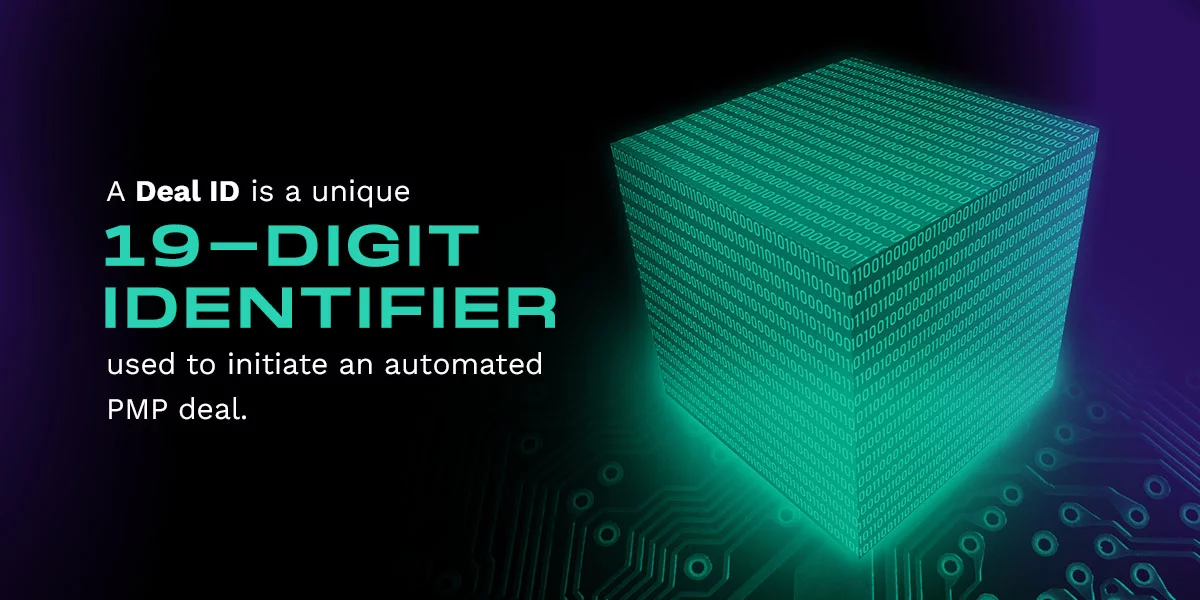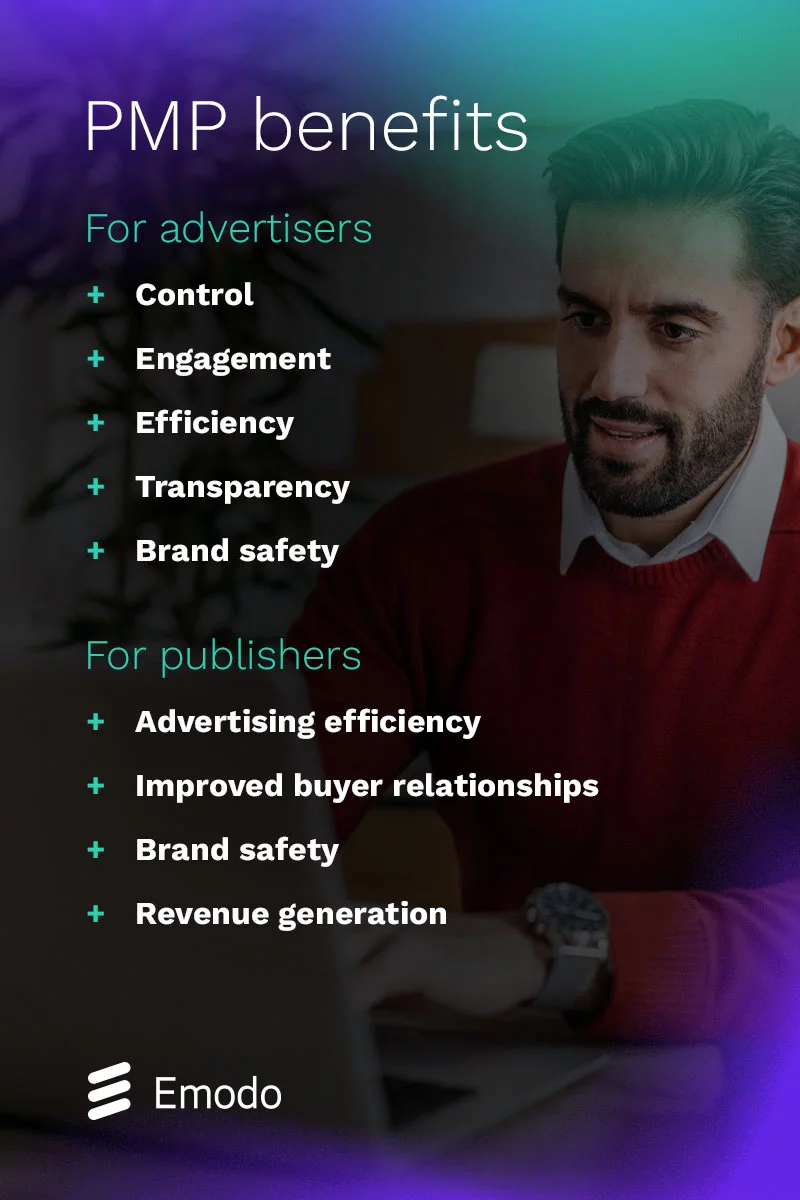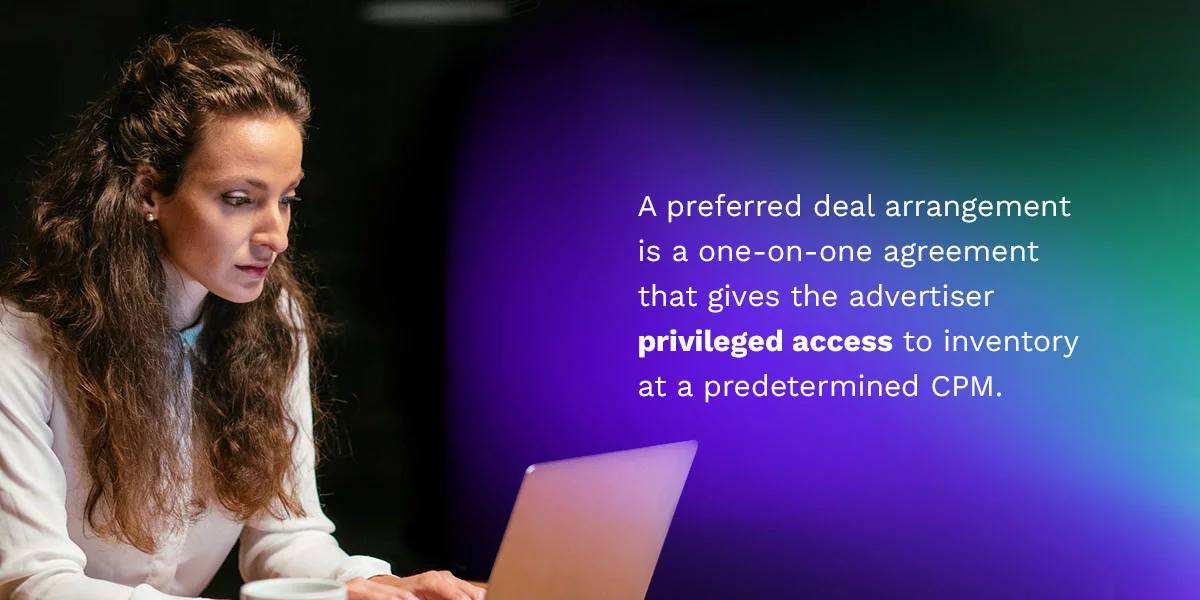Traditional programmatic advertising marketplaces operate randomly, so there’s no way to ensure you deliver a good user experience. You can solve this issue by using a private marketplace (PMP), meaning you’ll get total control over who buys your impressions or which impressions you buy.
This brief guide explains everything you need to know about using PMPs for marketing today, from how they work to the benefits of using them.
What is a private marketplace?
A PMP is a specific type of real-time bidding (RTB), an automated ad-buying method that allows parties to buy and sell hundreds of impressions in just milliseconds. PMPs first entered the programmatic advertising scene around 2014, the same year header bidding first appeared.
When a user clicks on a website, the publisher sends a request to an ad exchange with information about the page and the user. If the impression matches their predefined parameters, advertisers can respond to this request with a bid. The bidding ends when the publisher’s floor price is met.
First, let’s define how the marketplace works in advertising. Traditional RTB auctions take place in an open exchange, meaning they’re open to everyone. A PMP auction, however, uses the RTB process in a private exchange. Publishers hand-pick which advertisers they want to participate in the auction, giving them total control over which ads appear on their sites.
Most publishers that use PMPs are large sites with premium inventory, like trusted news sites and blogs. While PMPs are beginning to gain popularity with a broader audience, they’re still mostly limited to these big brands.
What is a Deal ID?

Deal IDs are the main differentiator between the open marketplace and PMP advertising. A Deal ID is a unique 19-digit identifier used to initiate an automated PMP deal. It contains important information about the deal, such as:
- Priority
- Floor pricing
- Transparency
- Audience data
Each automated transaction has its own time-sensitive Deal ID, which expires once the auction has ended. Generating a unique ID for each deal helps prevent bots and malicious actors from entering the auction with fraudulent or expired IDs, reducing ad fraud risk.
Publishers can use a first-party ad server or a supply-side platform (SSP) to generate a Deal ID once the deal has been created. It then sends this ID to the desired advertisers and demand-side platforms (DSPs), who respond with the same ID to accept the offer and place a bid. The advertiser who presents the highest bid wins the auction, and their ad loads on the site.
How does a PMP work?
While PMP deals may seem complex at first glance, they’re actually quite simple. Before an advertiser participates in a PMP auction, they negotiate terms and parameters with the publisher. These terms usually include, but are not limited to:
- Ad type
- Ad format
- Floor price
- Bidding technique
The auction itself begins when the user clicks onto a web page. The web browser sends a request to the ad server to start the auction.
Then, the publisher’s advertising platform generates a unique Deal ID for each bid request, which it passes on to the advertiser’s DSP. The DSP then recognizes the deal and makes a bid if the request matches the advertiser’s predefined parameters.
Like in an open market auction, advertisers bid on inventory using a cost-per-mille (CPM) model, which enables them to buy thousands of impressions at once. Also, like standard RTB auctions, PMP auctions take place in the few milliseconds it takes for the page to load.
Why are PMPs becoming more popular?
Although buying inventory through a PMP often costs more than buying through the open marketplace, PMP sales overtook open programmatic advertising spend in 2020 — and this trend has continued through 2023.
The biggest reason for this shift? Ad fraud.
Digital ad fraud affects publishers and advertisers differently:
- Advertisers: Due to the limited transparency of the open marketplace, advertisers can accidentally buy impressions from bots posing as publishers — meaning only bots will see their ads.
- Publishers: In the open marketplace, malicious actors can buy impressions for ads containing malware — which is dangerous for a publisher’s brand. Additionally, bots posing as advertisers can purchase valuable inventory, deflating its value and reducing the potential revenue publishers can expect.
Recent years have seen a significant increase in digital ad fraud incidents. In 2022, the estimated cost of global digital ad fraud came to roughly $81 billion. And this figure is only expected to rise — by the end of 2023, experts estimate digital ad fraud will cost about $100 billion worldwide.
Private marketplaces significantly reduce this risk by limiting the parties involved in an auction. Publishers can choose which advertisers they sell inventory to, and advertisers can choose whether to accept the invitation.
PMP benefits
Because PMPs are so exclusive, they offer unique advantages over other types of programmatic advertising. Both publishers and advertisers have direct control over each transaction, which helps reduce the risks involved with anonymous, randomized RTB auctions.
Here are some of the other ways private marketplaces can benefit advertisers and publishers.
For advertisers
The main benefits of private marketplace advertising on the buyer’s side include the following:
- Control: PMPs enable advertisers to select the specific inventory they bid on, providing more opportunities for increasing viewability and improving brand image.
- Engagement: High viewability provides greater opportunities to connect with audiences through memorable creative experiences.
- Efficiency: Like the open marketplace, PMPs use automated bidding algorithms to buy and sell inventory, enabling advertisers to secure premium impressions in less time than traditional direct sales.
- Transparency: Advertisers have greater access to publisher data in PMPs. With clear insights into the publisher’s inventory, advertisers can build a more informed ad-buying strategy.
- Brand safety: Because advertisers know the publishers they are buying inventory from, there’s a much lower risk of buying inventory on a page that doesn’t match their brand.
The main drawback to PMPs for advertisers is that a Deal ID is mandatory to participate in the auction. If you don’t get an invite from the publisher, you can’t purchase their inventory.
For publishers
Ultimately, PMPs help publishers deliver an excellent user experience by connecting them to hyper-relevant advertisers. Other primary advantages of using PMPs include the following:
- Advertising efficiency: PMPs are automated, which enables publishers to get high returns without spending as much time and effort as they would on direct ad sales.
- Improved buyer relationships: PMPs enable publishers to work with advertisers to negotiate terms before the auction begins. This dynamic helps them build a stronger relationship over time, which can help ensure impression sales in the future.
- Brand safety: Publishers have complete control over which advertisers can bid in a PMP auction, reducing the risk of ad fraud. PMPs also allow publishers to connect with their audiences without relying on third-party cookies.
- Revenue generation: Advertisers are willing to pay more for premium inventory, so publishers can charge more in PMPs. Whatever does not sell in a PMP usually goes on to sell in an open auction, albeit for a lower price.
The main drawback to using PMPs for publishers is that it can be challenging to maintain enough high-quality inventory to keep buyers interested, which can affect your bottom line. This is one of the biggest reasons why most PMPs are for established publishers with large audiences.

PMP vs. programmatic media buying
While they may seem different on the surface, PMPs are actually a type of programmatic advertising.
Programmatic advertising is an umbrella term that refers to any digital media buying method that uses automation and algorithmic tools to buy and sell impressions. Because PMPs use an RTB algorithm to automate auctions, a PMP is essentially a programmatic private marketplace.
Like other programmatic advertising techniques, PMPs also analyze user signals through first-party cookies to ensure a good match between advertisers and publishers. This functionality helps both parties deliver the right ads to the right people at the right time, which is critical for high audience engagement.
PMP vs. open market
The open advertising marketplace once made up the bulk of programmatic ad spend — in the past few years, though, PMPs have replaced it.
Both open market auctions and PMPs use a real-time bidding algorithm to power ad sales. The main difference between the two is that a PMP is invite-only, whereas an open market is open to anyone.
Any publisher or SSP can offer impressions in an open exchange, and any advertiser or DSP can place a bid. In a PMP, only one publisher sells impressions, and only a select group of advertisers the publisher chooses may place bids on inventory.
Additionally, PMP deals usually involve better inventory at higher prices. Most publishers set the floor price at a premium to drive up revenue generation, but the price is justified because it includes the best impressions.
That’s why a PMP is often a strategic component in a publisher’s marketing strategy. Usually, the publisher will offer the best inventory in a PMP sale and move whatever does not sell to the open market, where they can sell it at a lower price.
PMP vs. programmatic guaranteed
Also known as “programmatic direct,” programmatic guaranteed ad buying is the direct sale of reserved inventory between a publisher and their chosen advertiser.
Programmatic guaranteed auctions are dependent on building strong relationships between publishers and advertisers. Often, publishers will offer discounts and package deals to advertisers to entice them to return — programmatic guaranteed deals are one such example.
Although a guaranteed auction is still automated, it’s even more exclusive than your typical programmatic private marketplace deal. Both parties often discuss the minimum bid and deal parameters before beginning the auction with a new Deal ID. As a result, programmatic guaranteed deals offer advertisers a specific number of impressions at a fixed price.
Unlike programmatic guaranteed, PMPs do not provide advertisers with a set volume of impressions or a fixed price. Instead, it uses dynamic RTB algorithms to evaluate bids and determine a winner.
What are preferred deals?

You might also see preferred deals referred to as “spot buying” or “unreserved fixed rate.” Like programmatic guaranteed, a preferred deal arrangement is a one-on-one agreement that gives the advertiser privileged access to inventory at a predetermined CPM. However, there are a few differences.
In a preferred deal, the buyer has some wiggle room to negotiate their bid price. Unlike with programmatic guaranteed, though, the publisher doesn’t reserve the inventory for that buyer. The same goes for buyers — advertisers are not required to place bids in a preferred deal.
Here’s how it works. The publisher sends a Deal ID to the advertiser via their ad server or SSP, and the advertiser responds to the request using the same ID. If the advertiser’s bid is high enough, they can participate in the auction.
Advertisers can also opt out of preferred deals by setting a bidding price that is lower than the publisher’s minimum CPM. When the server reads this Deal ID, it will not consider the advertiser for the deal.
The future of PMPs
According to research from eMarketer, programmatic digital display ad spending is projected to grow to $141.96 billion in 2023 — that’s an increase of 15.2% from 2022. PMPs make up a steadily growing portion of that expenditure. PMP traffic has consistently outperformed open marketplace programmatic advertising since 2020.
Today, the PMP concept continues to evolve. For example, some adtech companies have begun offering multi-publisher PMPs, which use a universal Deal ID for greater efficiency.
The main limiting factor for most PMP advertising is scalability. The current iterations of PMPs aren’t very scalable, which is a barrier to entry for many small and mid-market parties.
However, PMP and ad exchange solutions from Emodo are accessible to advertisers and publishers of any size or business type. Plus, they eliminate the need to rely on third-party cookies for accurate audience data, so you can make powerful connections with the right people.
How Emodo can help
While programmatic advertising technologies provide an ultra-efficient means for digital advertising, their lack of transparency can make it difficult to ensure your ads land with your audience.
That’s why we created Emodo Access and Emodo’s DSP. Our intelligent platforms connect advertisers to the right publishers — and vice versa — so you can deliver more impactful advertising for your audience.
Emodo Access, our SSP solution, helps publishers drive revenue generation by providing direct access to demand from Emodo’s DSP and other demand partners in our curated deals co-managed PMP service. In this offering, our team works closely with you to create ad deals that support your unique advertising goals. You’ll have full control over your campaigns while we take care of setup and optimization.
Participating in this offering maximizes competition among advertisers, and publisher-optimized rendering and yield-maximizing capabilities make your inventory pop regardless of ad format.
Emodo’s DSP helps advertisers do more with less through differentiated advertising solutions such as Emodo Adapt and Emodo Audiences. These technology integrations mean you can access all you need to control your campaigns from one unified platform, eliminating the expensive fees associated with other leading DSPs.
Maximize your opportunities with Emodo
At Emodo, we strive to enhance programmatic advertising by providing the best value for both advertisers and publishers. If you’re looking to make a deeper impression with your audiences, you can count on us to support you.
We can help you deliver ads that perform. Contact us today for more information about how you can maximize your digital marketing opportunities with Emodo.
MORE LIKE THIS



